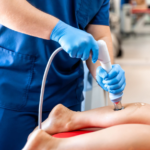“The greatest glory in living lies not in never falling, but in rising every time we fall.” Nelson Mandela’s words hit home for athletes with sports injuries. At our physiotherapy clinic, we know the physical and emotional hurdles of recovery. We’re here to help you get back stronger than ever.
In this guide, we show how our physio team helps Aussie athletes bounce back from injuries. We talk about the need for early action, common injuries, and the key role of physiotherapy. Our aim is to give you tips and strategies to stay fit and healthy, both on and off the field.
We’re committed to helping athletes get back to their best. Our physiotherapists use proven methods and custom plans to help you regain strength and confidence. We’re all about supporting you every step of the way.
Key Takeaways
- Early intervention is crucial for effective sports injury rehabilitation
- Identifying common sports injuries helps guide targeted treatment plans
- Physiotherapy plays a vital role in the recovery process
- Tailored rehabilitation programs are essential for optimal recovery
- Injury prevention strategies help minimise future risks
Understanding Sports Injury Rehabilitation
Early treatment is crucial for sports injuries. Seeking help quickly can reduce injury severity and speed up recovery. Our physiotherapy clinic focuses on timely care to help athletes return to their active lives safely and fast.
- Ankle sprains
- Hamstring strains
- Knee ligament injuries (ACL, MCL)
- Rotator cuff tears
- Tennis elbow
The Importance of Early Intervention
When an injury happens, the body naturally inflames. But too much inflammation can harm tissues and slow healing. Early physiotherapy, like ice therapy and gentle exercises, helps control inflammation and aids healing.
The sooner you start treatment, the sooner you can get back to doing what you love.
Identifying Common Sports Injuries
It’s important to know the signs of common sports injuries. Look out for pain, swelling, and reduced movement. Our physiotherapists can spot these signs and create treatment plans tailored to each patient.
The Role of Physiotherapy in Recovery
Physiotherapy is key in sports injury recovery. It combines manual therapy, exercises, and education to help patients regain strength and function. We aim to treat the injury and prevent future ones by fixing biomechanical issues.
Understanding early intervention, identifying injuries, and using physiotherapy expertise helps athletes recover well. They can confidently return to their sports.
The Physiotherapy Process
At our physiotherapy clinic, we have a detailed process for sports injuries. We tailor our care to each person, focusing on their needs and goals. This helps them recover fully.
Initial Assessment and Diagnosis
The first step is the initial assessment. Our skilled physiotherapists examine the injured area closely. They check movement, strength, and pain levels. They also talk about the client’s medical history and how the injury happened.
We use various tools for a precise diagnosis. This includes physical tests and imaging. This helps us create a treatment plan that meets each client’s needs.
Goal Setting for Rehabilitation
After understanding the injury, we set realistic goals with our clients. These goals might include:
- Reducing pain and inflammation
- Improving range of motion and flexibility
- Restoring strength and stability
- Returning to pre-injury activities or sports
Setting clear goals helps us track progress. We can then adjust the treatment plan for the best results.
Treatment Techniques We Use
We use many evidence-based techniques for recovery. These include:
| Technique | Purpose |
|---|---|
| Manual therapy | To reduce pain, improve mobility, and promote healing |
| Exercise therapy | To restore strength, flexibility, and function |
| Dry needling | To release muscle tension and trigger points |
| Electrotherapy | To manage pain, reduce inflammation, and promote healing |
We combine these techniques with a home exercise program. This aims to enhance the healing process and help clients reach their goals.
The key to successful rehabilitation is a collaborative approach between the physiotherapist and the client, working together to set goals and implement an effective treatment plan.
The Benefits of Physiotherapy
Physiotherapy is key for sports injury recovery. It helps athletes manage pain, regain function, and prevent future injuries. Our skilled physiotherapists aim to get you back to your sport safely and quickly.
Pain Management Strategies
Managing pain is a main goal of physiotherapy. We use various methods to ease discomfort, including:
- Manual therapy, such as soft tissue massage and joint mobilisation
- Electrotherapy modalities, like TENS and ultrasound
- Heat and cold therapy to reduce inflammation and promote healing
- Exercise prescription to improve flexibility and strength
By focusing on pain’s source, we help you find relief and aid in your recovery.
Restoring Function and Movement
Restoring function and movement is crucial in physiotherapy. We use specific exercises and techniques to:
- Improve joint mobility and flexibility
- Increase muscle strength and endurance
- Enhance balance and proprioception
- Retrain proper movement patterns
Our aim is to help you regain the physical skills needed for top sports performance.
Preventing Future Injuries
Physiotherapy also focuses on preventing future injuries. We do this through:
| Prevention Strategy | Description |
|---|---|
| Education | Teaching proper training techniques and body mechanics |
| Prehabilitation | Strengthening and conditioning exercises to address potential weaknesses |
| Customised Programs | Developing individualised injury prevention plans based on your specific needs |
“An ounce of prevention is worth a pound of cure.” – Benjamin Franklin
By adding these strategies to your training, you can lower the risk of future injuries. This way, you can enjoy a longer, healthier athletic career.
Individualised Rehabilitation Programs
At our physiotherapy clinic, we know every athlete is different. They have unique needs and goals for sports injury rehab. That’s why we focus on individualised rehabilitation programs. Each athlete gets a treatment plan that’s just right for them.
Our skilled physiotherapists work one-on-one with each athlete. They create tailored programs that match the athlete’s injury, fitness, and sport needs. This personal touch helps athletes get back to their sport safely and quickly.
Tailoring Programs to Fit Our Needs
Our physiotherapists think about many things when making a rehab program. They look at:
- Type and severity of the injury
- Athlete’s age and overall health
- Pre-injury fitness level and sport-specific demands
- Access to rehabilitation resources and support systems
This way, we make a program that’s both challenging and doable. Athletes progress safely and at the right pace.
Monitoring Progress and Adjustments
Our physiotherapists keep a close eye on each athlete’s progress. They make changes to the program as needed. This progress monitoring includes:
| Assessment Type | Frequency | Purpose |
|---|---|---|
| Range of motion tests | Weekly | To track improvements in joint mobility |
| Strength assessments | Bi-weekly | To monitor muscle strength and endurance |
| Functional movement screens | Monthly | To assess sport-specific movement patterns |
Regular checks help us keep the rehab program effective and up-to-date. We adjust exercises and treatments as the athlete gets better.
The individualised approach to rehabilitation has been a game-changer for me. The physiotherapists really took the time to understand my specific needs and created a program that challenged me while still being achievable. I felt supported every step of the way.
The Role of Exercise in Recovery
Exercise is key in sports injury recovery. At our physiotherapy clinic, we use active rehabilitation to help patients regain strength and function. Passive treatments like rest and ice only offer temporary relief. It’s through targeted exercises that we promote healing and prevent future injuries.
Active rehabilitation and passive treatment differ. Passive treatment includes techniques like massage or electrical stimulation. These can help manage pain but don’t actively engage muscles and joints. Active rehabilitation, however, involves exercises that patients do themselves, under a physiotherapist’s guidance. These exercises target specific weaknesses and help the body become stronger.
Types of Exercises for Specific Injuries
Exercises for active rehabilitation vary based on the injury and patient needs. For example:
- For a sprained ankle, we focus on range of motion, balance, and ankle muscle strengthening.
- For a torn rotator cuff, exercises improve shoulder mobility, stability, and strength.
- For a hamstring strain, we use stretching and strengthening to aid healing and prevent future injury.
Our approach is always tailored to the patient. We assess their abilities, set goals, and create a program that challenges them safely.
Importance of Strength and Flexibility Training
Strength and flexibility training are also crucial in recovery. Strengthening muscles around an injured joint provides support and stability, reducing re-injury risk. Flexibility training keeps joints mobile and prevents stiffness and pain.
| Injury | Strength Training | Flexibility Training |
|---|---|---|
| Ankle Sprain | Theraband exercises, single leg balance | Calf stretches, ankle circles |
| ACL Tear | Leg press, squats, lunges | Hamstring and quad stretches |
| Tennis Elbow | Wrist curls, grip strengthening | Forearm stretches, wrist extensions |
Our goal is to help patients recover and stay healthy long-term. By focusing on active rehabilitation, specific exercises, and strength and flexibility training, we empower them to enjoy sports and activities with confidence.
Hands-on Techniques in Physiotherapy
At our physiotherapy clinic, we use many hands-on methods to help with sports injury recovery. These methods help reduce pain, improve movement, and aid in healing. This way, our patients can get back to their favourite activities safely and quickly.
Manual Therapy Techniques
Manual therapy is key in our sports injury rehab. Our physiotherapists use their hands to apply pressure and stretch soft tissues and joints. This helps lessen pain and boost movement. We use various manual therapy techniques, including:
- Massage
- Joint mobilisation
- Myofascial release
- Trigger point therapy
Dry Needling and Acupuncture
We also use dry needling and acupuncture to aid in recovery. These methods involve fine needles in specific body points to ease pain and promote healing. Our physiotherapists are skilled in these techniques and decide if they’re right for your injury and goals.
“Dry needling has been a game-changer for my recovery. I can feel the difference in my muscle tension and pain levels after just a few sessions.” – Sarah, soccer player
Application of Taping Methods
Taping is another valuable tool for us. We use special tape on injured areas to offer support and reduce pain. The taping methods we use include:
| Taping Method | Benefits |
|---|---|
| Kinesiology taping | Reduces pain, improves circulation, and supports muscles |
| Rigid taping | Provides stability and support to injured joints |
| Elastic taping | Allows for movement while providing gentle support |
We combine these hands-on techniques with personalised exercise programs and patient education. This comprehensive approach helps our patients reach their recovery goals and enjoy their favourite activities again.
Addressing Mental Health in Recovery
Sports injury recovery is more than just fixing the body. It’s also about tackling mental health issues that come with an injury. At our physiotherapy clinic, we focus on supporting our patients’ emotional health during recovery.
Overcoming Psychological Barriers
Injuries can make people feel frustrated, anxious, or even depressed. These feelings can slow down recovery if not tackled. Our physiotherapists help patients face these challenges. They use methods like setting goals, positive thinking, and mindfulness to build resilience and stay positive.
Building Confidence and Resilience
Rebuilding confidence is key in sports injury rehab. We help set and celebrate small goals. This builds strength and trust in the body. Focusing on progress helps athletes stay strong and resilient during recovery.
“The support and encouragement I received from my physiotherapist made all the difference in my recovery. They not only helped me physically but also gave me the mental strength to keep going.” – Sarah, former patient
Support Systems: Family and Friends
A strong support system is vital for mental health during recovery. We urge patients to rely on family and friends for emotional and practical help. Here’s how loved ones can assist:
| Type of Support | Examples |
|---|---|
| Emotional | Listening, offering encouragement, celebrating progress |
| Practical | Helping with daily tasks, providing transportation to appointments |
| Social | Planning low-impact activities, maintaining social connections |
We aim to offer full care for sports injury recovery. This includes both physical and mental support. Our goal is to help patients return to sports with confidence and resilience.
Nutrition and Recovery
Recovering from a sports injury is not just about physical therapy. Nutrition plays a big role in healing too. Just like we fuel up for sports, we need the right food to help our bodies recover.
Fueling Our Body for Healing
When we’re injured, our bodies need more energy and nutrients. A balanced diet is key for repairing tissues and speeding up healing. Foods rich in:
- Protein: Essential for tissue repair and muscle rebuilding
- Vitamin C: Boosts collagen production, aiding in wound healing
- Omega-3 fatty acids: Help reduce inflammation and support joint health
- Zinc: Plays a key role in cell growth and tissue regeneration
The Role of Hydration
Drinking enough water is crucial, especially when recovering from an injury. Hydration helps by:
- Transporting nutrients to injured areas
- Removing waste and toxins
- Keeping joints lubricated and flexible
- Helping regulate body temperature during exercises
Drink at least 2-3 liters of water daily. More is needed if you’re doing physical therapy or exercising.
Supplements That May Aid Recovery
While a balanced diet is essential, some supplements can help too. Always talk to a healthcare professional before taking any supplements. Some beneficial ones include:
| Supplement | Benefits |
|---|---|
| Glucosamine and Chondroitin | Supports joint health and cartilage repair |
| Creatine | Enhances muscle strength and supports recovery |
| Branched-Chain Amino Acids (BCAAs) | Promotes muscle recovery and reduces soreness |
“Let food be thy medicine and medicine be thy food.” – Hippocrates
By focusing on nutrition and hydration, we help our bodies heal and recover. Remember, taking care of our bodies is as important as physical therapy and exercises.
Return to Sport Guidelines
We know how much athletes want to get back to their sport after an injury. But, it’s important to do it safely and carefully. Our physiotherapists will help you every step of the way. They’ll check if you’re ready and support you with ongoing care.
Assessing Readiness for Return
Before saying it’s okay to start playing again, we do a detailed check. We look at things like:
- Pain levels and how well you can move
- How flexible you are
- Your strength and how long you can keep going
- How balanced and aware of your body you are
- How well you can do sport-specific skills
This helps us figure out if you’re ready to play your sport again.
Gradual Return Strategies
When you’re ready, we create a plan just for you. This plan helps avoid injuries and lets your body get used to the sport again. Here’s what a typical plan might look like:
| Stage | Activities | Duration |
|---|---|---|
| 1 | Light aerobic exercise, no sport-specific drills | 1-2 weeks |
| 2 | Moderate intensity exercise, basic sport-specific skills | 2-3 weeks |
| 3 | High intensity training, advanced sport-specific drills | 2-3 weeks |
| 4 | Full return to sport, with ongoing maintenance | Ongoing |
Ongoing Maintenance and Monitoring
Even after you’re back playing, we keep an eye on you. We want you to stay at your best and avoid injuries. This might include:
- Regular check-ins with our physiotherapists
- Personalised strength and conditioning programs
- Advice on proper warm-up and cool-down routines
- Guidance on nutrition and recovery strategies
The journey back to sport after an injury can be challenging, but with the right support and guidance, it’s entirely possible. Trust in the process and lean on your physiotherapist every step of the way.
At our clinic, we’re dedicated to helping athletes safely get back to their sports. We want to help them reach their goals, no matter how big or small.
Preventative Strategies for Athletes
As the saying goes, “an ounce of prevention is worth a pound of cure”. This is especially true for sports injuries. Physiotherapy is key in rehab, but athletes must also focus on preventing injuries.
We help athletes create routines to lower injury risk at our physiotherapy clinic. These routines include strength training, flexibility exercises, and drills specific to their sport.
Developing a Routine to Minimise Injuries
Creating a consistent routine is vital for injury prevention. It should include proper warm-up and cool-down. A good warm-up gets the body ready for sports, improving blood flow and flexibility. A cool-down helps the body recover, reducing soreness and stiffness.
Importance of Warm-up and Cool-down
Warm-up and cool-down are crucial. Studies show athletes who do these routines get injured less often. They help by improving blood flow, flexibility, and mental focus, and reduce muscle injuries.
- Increased blood flow to the muscles
- Improved flexibility and range of motion
- Enhanced mental preparation and focus
- Reduced risk of muscle strains and sprains
- Faster recovery between training sessions
Sport-Specific Injury Prevention Techniques
It’s also important for athletes to use sport-specific injury prevention techniques. These are tailored to the demands and common injuries of each sport. For example, runners might focus on hip and core strength to prevent knee injuries.
- Runners may focus on hip and core strengthening exercises to prevent knee and ankle injuries
- Swimmers may emphasise shoulder and upper back flexibility to reduce the risk of rotator cuff strains
- Football players may incorporate plyometric exercises to improve landing mechanics and reduce the risk of ACL tears
Working with a physiotherapist helps athletes create injury prevention programs. These programs are based on the athlete’s needs, injury history, and goals. With targeted exercises and proper technique, athletes can lower their injury risk and perform better.
Resources and Support
Recovering from a sports injury can be tough, but you don’t have to face it alone. In Australia, many resources and support systems are ready to help. You can find a qualified physiotherapist, use online resources, and join community support programs.
Finding a Qualified Physiotherapist
Finding the right physiotherapist is key for sports injury recovery. Look for someone who knows sports injuries well and has treated your type of injury. You can find them through the Australian Physiotherapy Association or get recommendations from doctors or sports clubs.
Useful Online Resources
The internet is full of helpful info for athletes with sports injuries. Here are some great websites to check out:
- Sports Medicine Australia: It’s full of info on preventing, treating, and rehabbing injuries.
- Physiotherapy Exercises: It has a big database of exercises and rehab plans for different injuries.
- Australian Institute of Sport: It has articles and videos on managing injuries and getting back to sports.
Community Support Programs in Australia
Meeting others who’ve had similar injuries can really help. Here are some community support programs in Australia:
| Program | Description |
|---|---|
| Sports Injury Support Network | It offers support and resources for athletes with sports injuries. |
| Sporting Chance | It provides mentorship and support for athletes coming back to sports after injury. |
| Beyond Blue | It offers mental health support and resources for athletes dealing with injury’s emotional side. |
“Having a strong support system can really help in your recovery. Don’t hesitate to ask for help when you need it.”
You’re not alone in your sports injury recovery. Use a qualified physiotherapist, check out online resources, and join community support programs. This way, you can have a successful recovery and get back to the sport you love.
Success Stories in Sports Injury Rehabilitation
We’ve seen many athletes and individuals overcome their sports injuries. Their stories show the power of hard work, resilience, and our rehabilitation programs.
Our team has helped many athletes get back to their sports. We’ve worked with footballers and runners, helping them regain strength. This has allowed them to achieve their goals and excel in their careers.
Testimonials from Physiotherapy Clients
Our clients have shared their experiences, showing how our services have helped them. Their stories motivate others facing similar challenges. We’re grateful for their trust and strive to provide the best care for their recovery.
Inspiring Journeys of Overcoming Injuries
Every success story in sports injury rehabilitation is unique. Yet, they all show the importance of perseverance and physiotherapy. We support our clients from the start to the end, helping them overcome injuries and become stronger.







